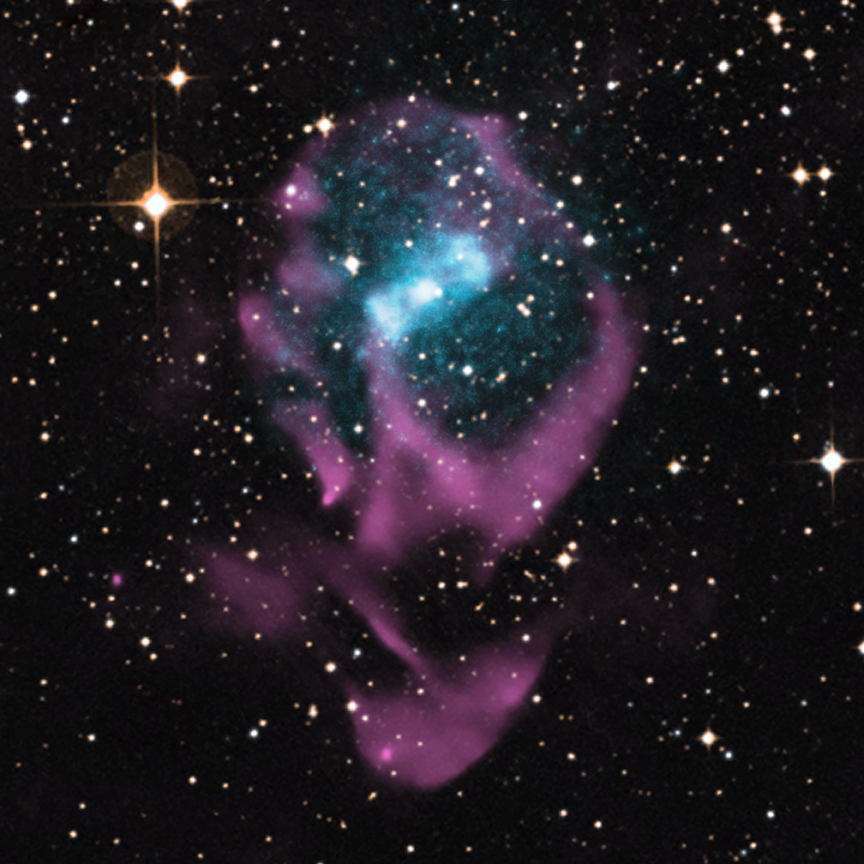An international team of astronomers – including SRON-researcher Peter Jonker – has found a neutron star which acts like a black hole in many ways. An extraordinary set of rings surrounding the neutron star system led to the conclusion that the neutron star is very bright at times and that it produces jets with at least 99,9% of the speed of light. Up until now this behavior was predominantly associated with black holes. The research results have appeared in the Astrophysical Journal today.

Neutron stars have a mass roughly 1,5 times the mass of our sun. But the diameter of the neutron star is only 10 kilometers whereas our sun has a diameter of 700,000 kilometers. So a neutron star has an astounding density, resulting in matter we cannot produce on Earth. Circinus X-1, the first X-ray source in the Circinus constellation, is a double star system containing such a neutron star orbiting a massive star. With the X-ray telescope Chandra (NASA) the researchers found extraordinary rings of X-ray light surrounding the neutron star system. The team found them to be echoes of X-ray light coming from an earlier burst of X-rays.
Team leader Sebastian Heinz (University of Wisconsin): “These light echoes were produced when Circinus X-1 emitted a burst of X-rays in 2013, which then bounced off clouds of dust. Some of these reflected X-rays then headed towards Earth. Because the X-rays have bounced to produce the echo, they had to travel in a triangular path back to observers using Chandra. This allows researchers to use simple geometry to accurately determine the distance to Circinus X-1 from Earth.”
The Chandra data reveal four concentric rings radiating outward from the neutron star (see illustration), the largest and brightest rings ever seen from an X-ray light echo. By combining the X-ray data with radio data the astronomers pinned the distance of the light echo to Circinus X-1 to 30,000 light years from Earth. This supports a previous result by a group led by co-author Peter Jonker from SRON, but contrasts with another published distance estimate of only about 13,000 light years for this system.
Jet
This increased distance would mean that Circinus X-1 is inherently much brighter in X-rays and other types of light than some scientists used to think. The new distance measurement indicates that Circinus X-1 has repeatedly passed a key threshold for brightness where the outward pressure from radiation by the system exceeds the inward pull of gravity. This behavior is something astronomers generally see more often in systems containing black holes rather than neutron stars.
With the now established distance the researchers also determined that the speed of the jet of high-energy particles produced by the system is at least 99.9% of the speed of light. This extreme velocity is usually associated with jets produced by a black hole.
(Chandra X-ray Observatory)
Event horizon
“Circinus X-1 acts in some ways like a neutron star and in some like a black hole,” said co-author Peter Jonker, of SRON, Netherlands Institute of Space Research. “It’s extremely unusual to find an object that has such a blend of these properties. Circinus X-1 allows us to better understand the relation between the capture of gas by a neutron star or black hole and the outflow in the form of a jet. These are important processes in the Universe but they are only poorly understood at present. Now we know that the black hole event horizon and spin are not responsible for the formation of the extremely fast jets, something that had been speculated before, as these are not present in the case of a neutron star.”
Team and telescopes
The team of astronomers that made the discovery: team leader Sebastian Heinz (University of Wisconsin), Peter Jonker (SRON Netherlands Institute for Space Research & Radboud Universiteit Nijmegen), Michael Burton (University of New South Wales), C. Braiding (University of New South Wales), W.N. Brandt (The Pennsylvania State University), R.P. Fender (University of Oxford), M.A. Nowak (Massachusetts Institute of Technology) en N.S. Schulz (Massachusetts Institute of Technology). The study is based on observations with the space telescopes Chandra (NASA) and XMM-Newton (ESA) and the Mopra radio telescope in Australia.
Publication
The research results appeared today in the Astrophysical Journal. Also open acces. Earlier this year Peter Jonker received a research grant of 2 million euros from the European Research Council (ERC). Jonker will use this grant to hunt for intermediate black holes.


